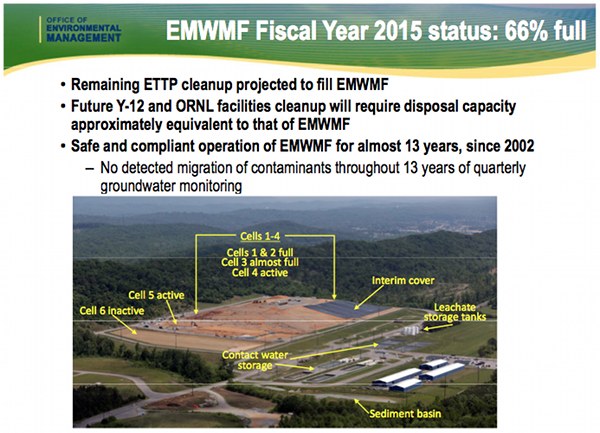
The proposed Environmental Management Disposal Facility would be built between the Y-12 National Security Complex and the Environmental Management Waste Management Facility, or EMWMF.
Oak Ridge officials will discuss the community impact of a proposed landfill that would hold waste from cleanup work at federal sites during a work session on Friday.
The Oak Ridge City Council work session is scheduled from 10 to 11:30 a.m. Friday, May 8, in the Municipal Building Training Room.
Council will be briefed on the Draft Community Impact Assessment of the proposed Environmental Management Disposal Facility by Karl Kalbacher, project manager for The Ferguson Group, a company that helps the city with its federal legislative agenda in Washington, D.C.
The Environmental Management Disposal Facility would be built on Bear Creek Road west of the Y-12 National Security Complex near another landfill that is already in use and has been operating since 2002. It could cost $1 billion, including construction and 23 years of operations.
But federal officials said the new landfill could save $1 billion in on-site versus off-site costs. That’s because the waste would be disposed on site and wouldn’t have to be shipped out of town, possibly to other states such as Nevada and Utah.
Saving money through on-site disposal could, in turn, accelerate the cleanup work at Oak Ridge National Laboratory and Y-12 National Security Complex, said Laura Wilkerson, federal project director for the Y-12 National Security Complex in the Oak Ridge Office of Environmental Management.
The earlier 43-acre, six-cell landfill is known as the Environmental Management Waste Management Facility. It has a capacity of 2.18 million cubic yards—about 872,000 pickup truck loads—and it is roughly 66 percent full. It’s expected to be filled by the remaining cleanup work at the East Tennessee Technology Park, also known as the former K-25 site, sometime around 2023. That’s assuming the cleanup program is funded at about $420 million per year.
Wilkerson said the remaining cleanup work at the Y-12 National Security Complex and Oak Ridge National Laboratory will require the ability to dispose of roughly as much waste as the EMWMF will hold.
The EMDF is projected to have a capacity of about 2.4 million cubic yards.
Like the EMWMF, the EMDF would have six disposal cells that could be built on an as-needed basis. The main difference between the new and old facilities is a stream. The EMDF will have to be engineered around that.
Federal officials hope to have what is known as a record of decision by 2016. Wilkerson said design work could begin in earnest this year or next, and site preparation and construction could start in 2019. The first cells could open in 2022.
In February, Wilkerson said the primary cleanup effort was at ETTP when the EMWMF was built, with some buildings at Y-12 and ORNL. But now there are more excess facilities at ORNL and Y-12, and the amount of projected waste has gone up, which explains the need for the new landfill.
K-25, Y-12, and ORNL, once known as X-10, were all built in the 1940s during the top-secret Manhattan Project in World War II. Many older buildings have been torn down or are being torn down, and the sites are being modernized or, in the case of K-25, converted to industrial use.
Wilkerson said there will be an opportunity for the public to comment on the EMDF. The city of Oak Ridge has hired a firm to help collect public input, Wilkerson said.
Federal officials estimate they’ve already saved about $500 million in off-site disposal costs using the EMWMF. They said they’ve helped maintain jobs in Oak Ridge, eliminated an estimated 130 million driving miles, and reduced handling and worker exposures.
Wilkerson said the on-site disposal is key to the program’s success.
About 86 percent of the waste from the former 44-acre K-25 Building, once the world’s largest under one roof, was taken to EMWMF. The same is true for the K-33 Building. Both buildings were at ETTP, the former K-25 site.
The landfill waste can include low-level radioactive waste, such as building debris, soil with low-level contamination, personal protective gear, scrap equipment, and asbestos. It does not include higher-activity waste, spent fuel, or transuranic waste.
Wilkerson said the EMWMF has operated safely for close to 13 years, and there has been no migration of contaminants detected through quarterly groundwater monitoring.
She said the new landfill needs to be ready at least 18 months before the existing facility reaches its capacity. The work to be completed before then includes site characterization, design, procurement, and public involvement. Construction work would have to start by 2019 to have the EMDF completed by 2022, Wilkerson said.











Leave a Reply